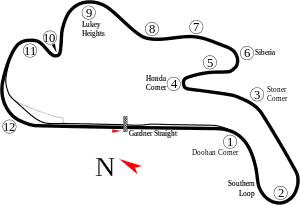Phillip Island 500
The Phillip Island 500 was an annual motor racing event, last held for Supercars at the Phillip Island Grand Prix Circuit in Phillip Island, Victoria. The race had three distinct eras; from 1971 to 1977 as an endurance production and later Australian Touring Car Championship race, from 2008 to 2011 as an endurance race as part of V8 Supercars and from 2017 to 2018 as a Supercars Championship event consisting of two 250 km races.
 | |
| Race Information | |
| Venue | Phillip Island Grand Prix Circuit |
| Number of times held | 13 |
| First held | 1971 |
| Last held | 2018 |
| Race Format | |
| Race 1 | |
| Laps | 57 |
| Distance | 250 km |
| Race 2 | |
| Laps | 57 |
| Distance | 250 km |
| Last Event (2018) | |
| Overall Winner | |
| DJR Team Penske | |
| Race Winners | |
| DJR Team Penske | |
| DJR Team Penske | |
History
Background
From 1960 to 1962, Phillip Island hosted the Armstrong 500, a 500-mile race which later evolved into the Bathurst 1000.
1971–77
The 1971 and 1972 races were open to Group E Series Production Touring Cars. With the demise of the Group E category at the end of 1972 the event switched to Group C Touring Car regulations. The 500K was a round of the Australian Manufacturers' Championship from 1971 to 1975 and counted towards both the Australian Championship of Makes and the Australian Touring Car Championship in 197s6 and 1977. The event name changed throughout this period according to the sponsorship (or lack thereof) each year.
Colin Bond and Peter Brock dominated the event in the 1970s, winning five of the seven events between them. In 1972, Allan Moffat won the event, in what is to this day the only Phillip Island 500 win for Ford.
2008–11
The race was revived in 2008 as two-driver endurance event for V8 Supercars, replacing the Sandown 500 as the lead-in event to the annual Bathurst 1000 race.[1][2] The format featured two short races on Saturday, one for each co-driver, that set the grid, before the traditional 500 km race on the Sunday. It remained part of the V8 Supercar Championship Series for four consecutive years before the Sandown 500 was reinstated as the host of the 500 km championship race for the 2012 season.
This iteration of the event was dominated by the Holden Racing Team and Triple Eight Race Engineering, winning two races each. The Triple Eight entry of Craig Lowndes and Jamie Whincup also led the other two events late in the race, before being overtaken by the Holden Racing Team's Garth Tander. The 2008 event saw Tander, driving with Mark Skaife, win after Whincup lost the lead due to an error.[3] In 2009, Tander, this time driving with Will Davison, passed Lowndes, who had a slowly deflating tyre, on the final lap.[3] For the 2010 season, a rules change forced a team's primary drivers to be split across their two cars, therefore Lowndes and Whincup were split up, with vastly different outcomes. Whincup lost a third race from the lead in three years following an engine failure, whilst Lowndes would go on to win, this time with Skaife.[3] This occurred ten years after Lowndes and Skaife had won the Queensland 500 driving together. The final running of the event in 2011 saw Lowndes and Skaife win again, leading home a Triple Eight one-two finish ahead of Whincup and Andrew Thompson.[3] The win saw Skaife level Colin Bond as the only drivers to win the event three times.
2017–18
In 2017, the Phillip Island SuperSprint format was dropped in favour of two 250 km races, which led to the revival of the Phillip Island 500 name.[4] The event itself was marred by a spate of tyre failures across the weekend, while Ford were also able to break their 45 year drought at the event.[5] After one more event using the format, the Phillip Island event returned to SuperSprint status in 2019.
Winners
Multiple winners
By driver
| Event Wins | Driver | Years |
|---|---|---|
| 3 | 1971, 1974, 1976 | |
| 2008, 2010, 2011 | ||
| 2 | 1973, 1975 | |
| 2008, 2009 | ||
| 2010, 2011 |
By team
| Event Wins | Driver |
|---|---|
| 4 | Holden Dealer Team |
| 2 | Holden Racing Team |
| Triple Eight Race Engineering |
By manufacturer
| Event Wins | Manufacturer |
|---|---|
| 10 | Holden |
| 3 | Ford |
References
- Phillip Island 500 here to stay
- Phillip Island 500 set to stay
- Greenhalgh, David; Howard, Graham; Wilson, Stewart (2011). The official history: Australian Touring Car Championship - 50 Years. St Leonards, New South Wales: Chevron Publishing Group. ISBN 978-0-9805912-2-4.
- Dale, Will (19 January 2017). "Supercars: Clipsal 500, Phillip Island and Pukekohe get new race formats for 2017". Fox Sports. Retrieved 16 February 2017.
- Howard, Tom (22 April 2017). "Supercars launches PI tyre investigation". Speedcafe. Retrieved 23 April 2017.
- Racing Car News, December 1971
- Racing Car News, December 1972, Pages 74 & 75
- Australian Competition Yearbook, 1974 Edition, Pages 139 & 140
- Australian Competition Yearbook, 1975 Edition, Pages 144 & 145
- Australian Competition Yearbook, 1976 Edition, Pages 114 & 115
- Australian Competition Yearbook, 1977 Edition, Pages 72 & 73
- Australian Competition Yearbook, 1978 Edition, Pages 70 & 71